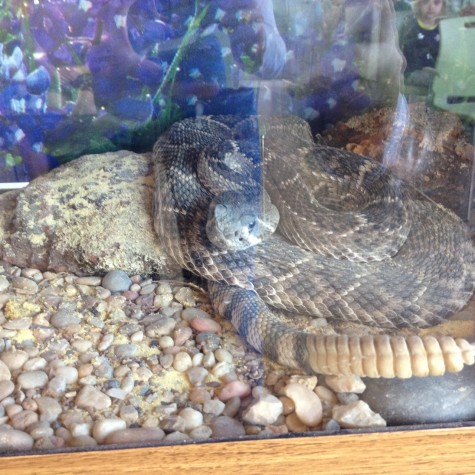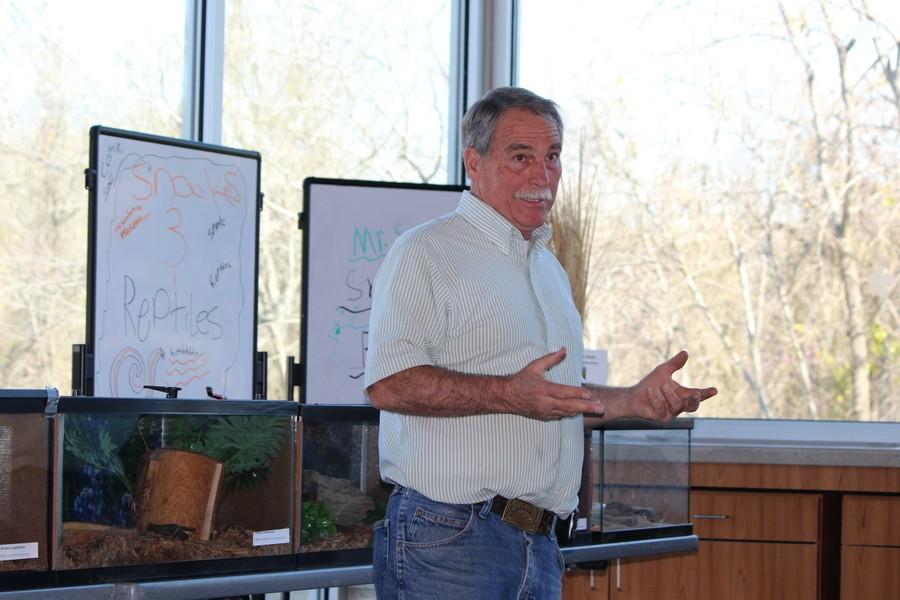‘Snake Man’ lectures about slithering serpents and other similar animals
March 8, 2016
Several tanks, filled with fake plants, branches, stones, wood chips and live snakes lined the table. Children crowded around the tanks eagerly. The snakes either hid under their logs or reared up to gaze directly into the eyes of the curious children.
The snakes in the tanks all belonged to Roger Sanderson, the Director of Horticulture for Texas Discovery Gardens. He is called the “Snake Man’’, due to having the largest live snake collection in Texas.
Sanderson came to lecture at the Coppell Nature Park Biodiversity Education Center on Saturday about snakes and reptiles, bringing along different species as a method of giving the attendees some “hands-on” experience. The lecture is part of the Friends of the Coppell Nature Park (FCNP) Lecture Series.
“The FCNP Lecture Series brings experts in the fields of conservation, environmental science, and nature study to the Coppell Biodiversity Education Center to share knowledge and training with outdoor enthusiasts and interested students,” FCNP board member Bill Sundermann said. “The series is a reflection of the Friends of Coppell Nature Park’s core values of environmental education and stewardship.”
Sanderson first discussed some of the misconceptions revolving around snakes, stating that the chance of being seriously harmed by a snake bite, or even getting bitten by one, is miniscule.
“The chance of seeing a snake [if you’re hiking in the woods] is very slim,” Sanderson said. “The chance of getting close enough to it or it to bite you is very slim. The chance you bothered him enough to bite you is very small. You have a better chance of being hit by lightning than being bit by a snake.”
According to Sanderson, most snakes are harmless, and most snakes have dry bites (which means the snake does not have venom). There are only four venomous snakes in the United States of America: the copperhead, the cottonmouth, the coral snake and the rattlesnake.
He then addressed the hypothetical, but rare scenario of getting bitten by a venomous snake, saying to first figure out if the snake is venomous by looking at the bite.
“[Venomous snakes] have fangs that inject venom like a hypodermic needle,” Sanderson said. “If it’s poisonous, there should be two puncture marks. Harmless snakes have a mouth full of needle-like teeth that are designed for holding onto prey.”
If one confirms that it is a venomous snake bite, then the next step is to get the affected person to the hospital as rapidly as possible. In most cases, snake bites are not fatal, but the venom is hemotoxic (meaning it affects the blood). The bitten area starts to swell, and the blood cells become deformed. The venom goes into the tissue, rather than the artery or veins, and oozes up the arm through the lymphatic system.
Sanderson then discussed some old, inaccurate treatments for snake bites, including putting on a tourniquet and sucking out the poison. Not only do these treatments not help, they can also aggravate the damage.
“Do not put on a tourniquet, because you cut off blood flow and the area beneath [the tourniquet] is pretty much going to die,” Sanderson said. “Sucking the poison out doesn’t really work because the venom bonds with the tissues and is not a liquid you can suck out, unless you do it immediately after the bite happens.”
The venom contains digestive enzymes that disintegrate tissues, and these enzymes cause the most damage. Gangrene may set in, and the person may have to amputate the affected area.
Sanderson then discussed the proper treatment, antivenin. Antivenin is made by collecting venom from venomous snakes, then injecting the venom into a sheep, starting off with a small concentration, then gradually increasing the dosage as the sheep builds up resistance.
The antivenin is then synthesized from the sheep’s resistant blood. Scientists used to create antivenins from horses, but the horse blood had not been compatible to human blood and created reactions in the body that had almost been as bad as the initial bite.
He then discussed how to tell the venomous snakes apart from the non venomous snakes, again dispelling some of the misconceptions regarding the various “tricks” for identifying a venomous snake.
“The ‘triangular head’ trick doesn’t really work, because many harmless snakes also want to look like they’re venomous, so they scrunch their necks and flatten their heads to look triangular,” Sanderson said. “The ‘elliptical pupils’ trick doesn’t work because you have to get dangerously close to a snake to see if it has elliptical pupils.”
The pit vipers (the venomous snakes) can all be identified by the pits in their face that can sense heat. This lets the snakes strike incredibly accurately, biting targets even in the dark.
Sanderson also gave detailed descriptions of each of the four venomous snakes. The rattlesnake actually has a physical rattle on the end of its tail, even though all snakes rattle their tail when upset. The copperhead has a very unique appearance unlike any other snake, having alternating dark brown and light brown bands around its body.

A rattlesnake is coiled in its tank. The rattlesnake belongs to Roger Sanderson, a snake expert that has the largest collection of live snakes in Texas.
For the cottonmouth, he removed a harmless blotched water snake from its tank and held it in his hands for the purposes of comparison, showing it to the attendees. The snake emitted an odor due to being disturbed from its normal location.
Despite the blotched water snake and the cottonmouth appearing fairly similar (short, fat, and black), Sanderson pointed out that the striped lip on the blotched water snake is the method to distinguish it from the cottonmouth.
The final snake, the coral snake, he stated, is different because its venom is neurotoxic (affecting the nerves rather than the blood). The snake is not very dangerous despite being venomous, due to being docile and not prone to biting, in addition to having stubby fangs that cannot bite through several materials.
“Most bites are to inebriated people that do something stupid and are trying to mess with the snake,” Sanderson said. “Baby snakes are usually more aggressive, but they have a lot less poison than adults. Adults are less prone to bite.”
Coral snakes appear very similar to milk snakes (a harmless species) but the method of telling them apart is the mnemonic “red and yellow: kill a fellow, red and black: friend of jack.” The coral snake has a yellow band around the red parts of its body. The milk snake, on the other hand, has a black band around the red parts of its body.
Sanderson then replied to an attendee’s question about dealing with snakes in the yard or house. His advice was to put a garbage can next to the snake, use a broom to flip it into the garbage can, then take the snake outside and release it. He warned, however, that adult snakes generally try to find their way back, due to perceiving the area as their “home range”.
“If you have a common problem with venomous snakes, put fencing around the property,” Sanderson said.
Finally, at the end of the lecture Sanderson showed several slides with photographs of various species of salamanders, frogs, toads, turtles, lizards, and some snakes, explaining the biology, geographical distribution, and behavior of each species.
“[The lecture] was very informative,” Coppell resident and lecture attendee Joel Wahl said. “I learned a lot about poisonous and non poisonous snakes.”











